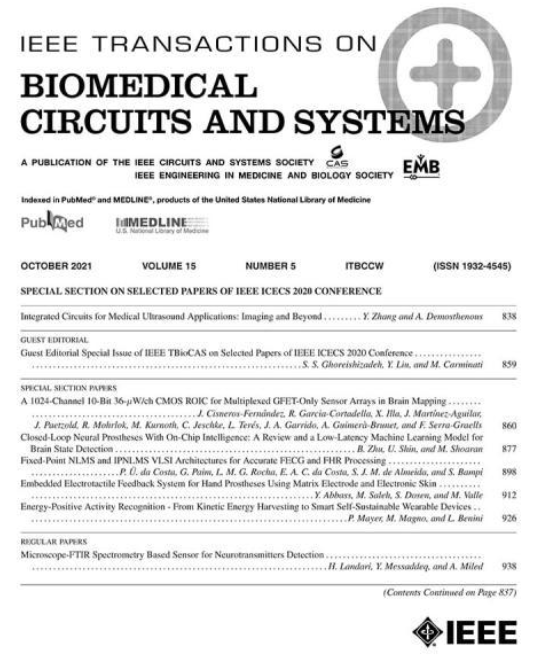微型介电光谱专用微流控cmos平台的9mhz - 2.4 GHz全集成收发器IC
IF 3.8
2区 医学
Q2 ENGINEERING, BIOMEDICAL
IEEE Transactions on Biomedical Circuits and Systems
Pub Date : 2015-12-01
DOI:10.1109/TBCAS.2015.2501816
引用次数: 17
摘要
本文介绍了一种完全集成的收发器IC,作为自维持的微流控cmos平台的一部分,用于从MHz到GHz的小型化介电光谱(DS)。该集成电路的发射(TX)部分采用AMS 0.35 μm 2P/4M射频CMOS制造,产生频率可调范围内的单音正弦信号,激发具有浮动电极和9 μL微流控通道的三维(3D)平行板电容式传感器进行样品输送。将待测材料(MUT)加载到传感器中,IC的接收器(RX)部分采用宽带频响分析(bFRA)方法测量射频激励信号通过传感器传输后的幅度和相位。然后,一次性的6点传感器校准算法从传感器在电压域的传输特性的IC测量中提取MUT复介电常数εr的实部和虚部。“传感器+ IC”完全能够在TX产生的~ 50 MHz, 500 MHz, 1.5 GHz和2.4 GHz四种激励频率下进行测试,区分去离子水(DI),磷酸盐缓冲盐水(PBS)和酒精饮料。此外,与IC接口的传感器在6个激励频率范围内的PBS介电常数读数与商用台式设备的体溶液参考测量值非常吻合(有效值误差为1.7%(实)和7.2%(虚))。IC的总功耗为1.5 V(模拟)和3.3 V(数字)电源。本文章由计算机程序翻译,如有差异,请以英文原文为准。
A 9 MHz–2.4 GHz Fully Integrated Transceiver IC for a Microfluidic-CMOS Platform Dedicated to Miniaturized Dielectric Spectroscopy
This paper presents a fully integrated transceiver IC as part of a self-sustained, microfluidic-CMOS platform for miniaturized dielectric spectroscopy (DS) from MHz to GHz. Fabricated in AMS 0.35 μm 2P/4M RF CMOS, the transmitter (TX) part of the IC generates a single-tone sinusoidal signal with frequency tunability in the range of to excite a three-dimensional (3D), parallel-plate, capacitive sensor with a floating electrode and 9 μL microfluidic channel for sample delivery. With a material-under-test (MUT) loaded into the sensor, the receiver (RX) part of the IC employs broadband frequency response analysis (bFRA) methodology to measure the amplitude and phase of the RF excitation signal after transmission through the sensor. A one-time, 6-point sensor calibration algorithm then extracts both the real and imaginary parts of the MUT complex permittivity, εr, from IC measurements of the sensor transmission characteristics in the voltage domain. The “sensor + IC” is fully capable of differentiating among de-ionized (DI) water, phosphate-buffered saline (PBS), and alcoholic beverages in tests conducted at four excitation frequencies of ~ 50 MHz, 500 MHz, 1.5 GHz, and 2.4 GHz generated by the TX. Moreover, permittivity readings of PBS by the sensor interfaced with the IC at six excitation frequencies in the range of are in excellent agreement (rms error of 1.7% (real) and 7.2% (imaginary)) with those from bulk-solution reference measurements by commercial benchtop equipment. The total power consumption of the IC is with 1.5 V (analog) and 3.3 V (digital) supplies.
求助全文
通过发布文献求助,成功后即可免费获取论文全文。
去求助
来源期刊

IEEE Transactions on Biomedical Circuits and Systems
工程技术-工程:电子与电气
CiteScore
10.00
自引率
13.70%
发文量
174
审稿时长
3 months
期刊介绍:
The IEEE Transactions on Biomedical Circuits and Systems addresses areas at the crossroads of Circuits and Systems and Life Sciences. The main emphasis is on microelectronic issues in a wide range of applications found in life sciences, physical sciences and engineering. The primary goal of the journal is to bridge the unique scientific and technical activities of the Circuits and Systems Society to a wide variety of related areas such as: • Bioelectronics • Implantable and wearable electronics like cochlear and retinal prosthesis, motor control, etc. • Biotechnology sensor circuits, integrated systems, and networks • Micropower imaging technology • BioMEMS • Lab-on-chip Bio-nanotechnology • Organic Semiconductors • Biomedical Engineering • Genomics and Proteomics • Neuromorphic Engineering • Smart sensors • Low power micro- and nanoelectronics • Mixed-mode system-on-chip • Wireless technology • Gene circuits and molecular circuits • System biology • Brain science and engineering: such as neuro-informatics, neural prosthesis, cognitive engineering, brain computer interface • Healthcare: information technology for biomedical, epidemiology, and other related life science applications. General, theoretical, and application-oriented papers in the abovementioned technical areas with a Circuits and Systems perspective are encouraged to publish in TBioCAS. Of special interest are biomedical-oriented papers with a Circuits and Systems angle.
 求助内容:
求助内容: 应助结果提醒方式:
应助结果提醒方式:


